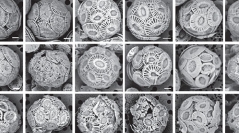

 Cryptogamie, Algologie
39 (4) - Pages 481-509
Cryptogamie, Algologie
39 (4) - Pages 481-509Emiliania huxleyi is a cosmopolitan coccolithophore exhibiting a high degree of genetic and physiological variability among strains and life-cycle stages. Here we investigated whether responses to copper (Cu) toxicity and oxidative stress varied by environmental origin or life cycle stage. We compared responses to toxic concentrations of Cu and short-term exposure to hydrogen peroxide of twelve strains (eight diploids and two pairs of strains where haploids and diploids shared a genetic background) from different oceanographic origins. Measured responses included growth rate, proportions of malformed/incomplete coccoliths (diploid strains), motility (haploid strains), variable fluorescence (Fv/Fm, a measure of photosystem health), flow cytometry assays of the percentages of live cells and the accumulation of intracellular reactive oxygen (ROS), and the activities of ascorbate peroxidase (AP) and glutathione peroxidase (GP). Although a large and significant variability was observable in Cu sensitivity among strains, no statistical differences were detected when strains were grouped by their origins. In the two diploid/haploid pairs, the diploids showed more sensitivity to growth inhibition by Cu than their corresponding haploids, although this was only large and significant in the case of diploid-haploid pair that originated from a Tasman Sea isolate (RCC1216/RCC1217). The diploids accumulate ROS rapidly in response to acute exposure to Cu, while ROS accumulation in haploids was much lower. Notably, there was no difference in Cu-induced ROS between the sensitive and resistant diploids or between the sensitive and resistant haploids. Differences in Cu-sensitivity between strains were reflected in differences in constitutive AP activity, but no differences between strains in constitutive or induced GP activity were detected. Overall, our results show a high intraspecific variability among genotypes and life-cycle phases in E. huxleyi, which might partly reflect differences in tolerance to oxidative stress.
Copper stress, coccolithophores, Emiliania huxleyi, strain-specific responses, life cycle